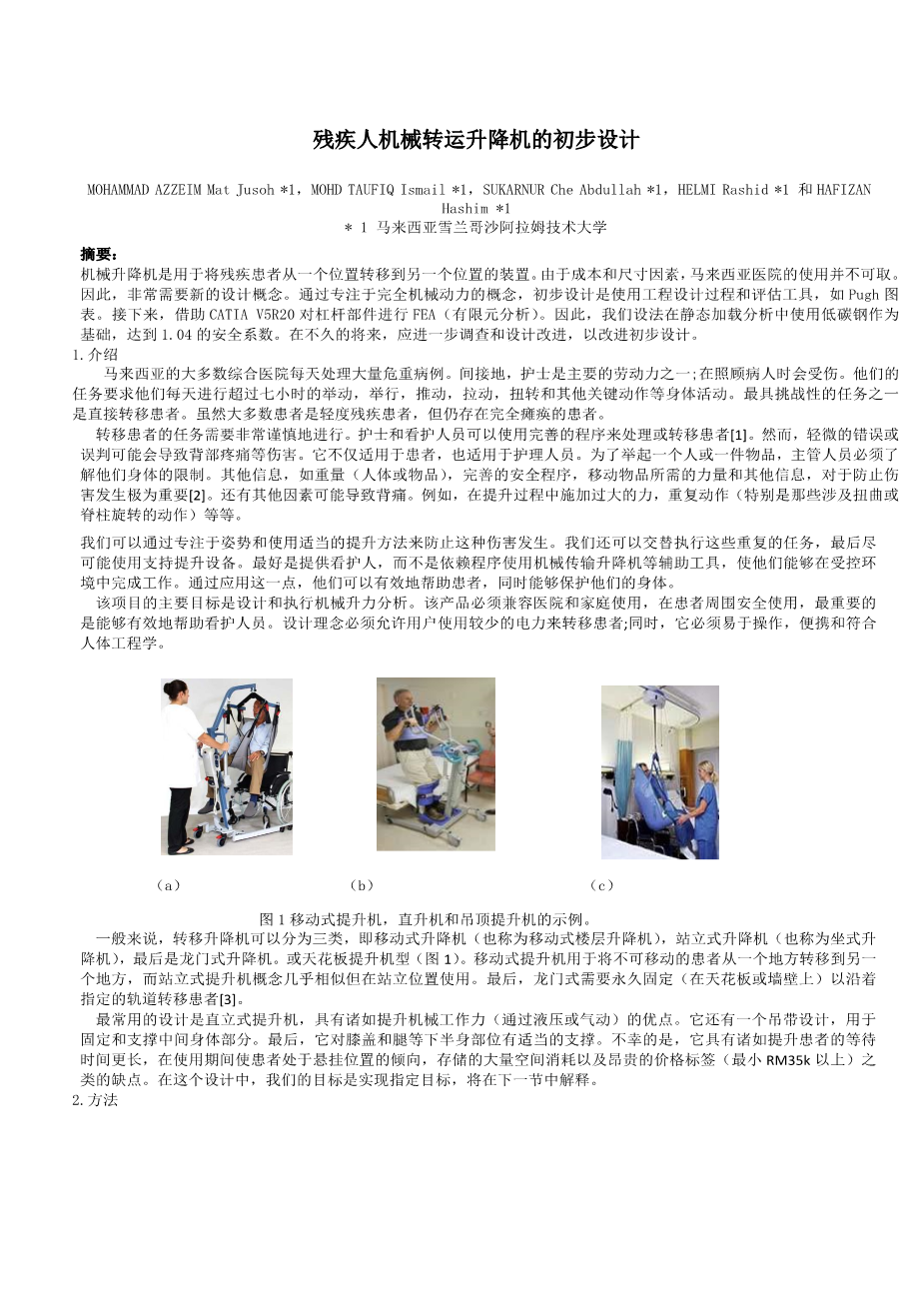
英语原文共 14 页
Preliminary Design of a Mechanical Transfer Lift for Disabled Patient
MOHAMMAD AZZEIM Mat Jusoh *1, MOHD TAUFIQ Ismail *1, SUKARNUR Che Abdullah *1, HELMI Rashid *1 and HAFIZAN Hashim *1
*1 Universiti Teknologi MARA, 40450, Shah Alam, Selangor, Malaysia.
Abstract:
The mechanical lift is a device for transferring disabled patient from one position to another. Due to the cost and size factor, the usage in Malaysian hospital was not preferable. Hence, the needs for a new design concept are highly required. By focusing on a fully mechanical powered concept, the preliminary design was made using the engineering design process and evaluation tools such as the Pugh chart. Next, an FEA (finite element analysis) was performed on the lever part through the aid of CATIA V5R20. As a result, we managed to achieve the safety factor of 1.04 during static loading analysis, using mild steel as base. In near future, further investigation and design improvement shall be made to improve the preliminary design.
- INTRODUCTION
Majority of general hospitals in Malaysia deals with a high number of critical cases every single day. Indirectly, the nurses as one of the main workforces; are exposed to injuries while caretaking the patient. Their task requires them to perform physical activities such as lifting, holding, pushing, pulling, twisting and others critical motion for more than seven hour a day. One of the most challenging tasks is to transfer the patients directly. While majority of the patients are those with minor disabilities, there are cases of fully paralyzed ones.
The task of transferring the patient needs to be performed with great care. Well-established procedures are available for nurses and caretakers for handling or transferring patient [1]. However, a slight mistake or misjudgment could lead to injuries such as back pains. It is not only to the patient, but also towards the caretakers. To lift a person or an item, the in-charge person must understand the limitation of their body. Other information such as the weight (of the human body or an item), well-established safety procedures, the amount of force required to move things and other information, is extremely important to prevent injuries from occurring [2]. There are also other factors which could contribute to back pain. For example, when exerting too much force during lifting, repetitious movements (especially those involving twisting or rotation of spine) and more.
We could prevent such injuries from occurring by focusing on posture and by using proper lifting method. We could also alternate these repetitious tasks and finally by using support-lifting devices whenever possible. Rather than depending on procedures, it is best to provide the caretakers
with assistive tools such as the mechanical transfer lift, so that they could perform their job within a controlled environment. By applying this, they could aid the patient effectively, at the same time able to protect their body.
The main objective of this project is to design and perform analysis towards the mechanical lift. The product must be compatible for hospital and domestic use, safe to use around patients, and most importantly able to assist the caretakers effectively. The design concept must allow the users to transfer patients using less power; at the same time, it must be easy to handle, portable and ergonomic.
(a ) (b) (c)
Fig. 1 Example of (a) Mobile hoists, (b) standing hoists and (c) ceiling hoists.
In general, the transfer lift can be divided into three categories, which are the mobile hoist type (also called the mobile-floor hoist), the standing hoist type (also known as the sit-to-stand hoist) and finally the gantry hoist or the ceiling hoist type (Fig.1). The mobile hoist is used to transfer non-movable patient from one place to another, whereas the standing hoist concept is almost similar but used during standing position. Finally, the gantry type needs to be permanently fixed (at ceiling or walls) to transfer patient along the specified track [3].
The most commonly used design is the standing hoists type, with benefits such as the mechanical work force to lift (either through hydraulic or pneumatic). It also has a sling design to hold and support the mid body section. Finally, it has a proper support on lower body parts such as knee and legs. Unfortunately, it comes with disadvantages such as longer waiting time to lift the patient, the tendency to leave the patient in hanging positions during usage, large space consumption for storage, and expensive price tag (minimum of RM35k onwards). In this design, our aim is to achieve
specified targets, which shall be explained in the next section.
- METHODOLOGY
Fig. 2 Design flowchart
As informed previously, the objective of this project is to design a mechanical transfer product using lifting mechanism via CATIA V5R20 software, to perform engineering analysis and simulation towards the design; especially in terms of structural strength. The design needs to be simple yet effective, by focusing on simple mechanical motion to lift the patient. It is more cost effective rather than depending on other mechanical element such as pneumatic or hydraulic forces.
Further analysis shall be made to evaluate the performance of the product. Other than that, the design must be optimized to extract maximum output force with minimum applied force, with ergonomic design, space efficient, portable, with low cost and weight, and reliable performances. Finally, the overall summary shall be made to compare the design objective versus the actual design. For
future project, a physical mockup of the product shall be made for physical and functional confirmation before proceeding to
资料编号:[3397]


